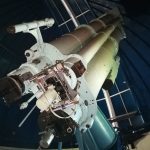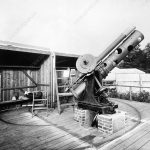| Frank McClean; LL.D.; F.R.S.; F.R.A.S. Amateur Astronomer Born: 1837 November 13 – Down, Ireland Died: 1904 November 8 – Brussels, Belgium |
|
|
|
|
| Famous for:
Frank McClean was a gifted amateur astronomer who for the first time discovered the spectra of oxygen in stars. As a result of his wealth he became a benefactor of astronomy and bequested a telescope to the Royal Observatory at the Cape of Good Hope. Summary: Frank McClean retired after only 11 years of working as an engineer. He spent the rest of his life as a very prominent amateur astronomer. He did important spectrographic work in astronomy, inventing his well-known star-spectroscope and also observed solar prominences. He published the spectra of 160 stars in the Journal Nature. McClean then made a bequest of a 61 cm (24 inch) telescope to the Royal Observatory at the Cape of Good Hope. In 1897 he visited the Cape Colony and using his telescope he photographed the spectra of another 116 stars. With this data he discovered the presence of oxygen in spectrographs from Beta Scorpii, Beta Canis Majoris, Beta Centauri, and Beta Crucis. For this work he was awarded the “Gold Medal of the Royal Astronomical Society in 1899. [Wiki] |
|
|
|
|
| History:
Frank McClean was the only son of a distinguished engineer, John Robinson McClean. He was born in Down, Ireland, on 13 November 1837. Frank was educated at Westminster School, then studied at Glasgow University, where he studied under Professor William Thomson (1824-1907; later Lord Kelvin), and then to Trinity College Cambridge, graduating as 27th Wrangler in the Mathematics Tripos in 1859. Frank joined his fathers firm in 1859 but retired in 1870, 11 years later to focus on artistic interests and scientific pursuits [MNRAS, p338 / Wiki] In 1871 the family bought an imposing property outside of Tunbridge Wells named Ferncliffe. McClean set up experiment with electricity and builds an Observatory where he stacked a 15-inch (38 cm) With-Browning reflector and a 6-inch (15 cm) Merz refractor on a sturdy equitorial mounting. During this time he started experimenting with spectroscopy and designed and patented a spectroscope that was named after him. This spectroscope was commercialized by the firm of John Browning of London. [Shears, p.2] In 1884 the McClean family moved from Ferncliffe to a new home, Rusthall House, on the other side of Tunbridge Wells. McClean set up a new observatory with the addition of a solar observatory (polar heliostat) that was housed in the roof of the building. It seems that he liked the concept of stacking telescopes because he designed a telescope with at least two tubes (minus the finder scope) – twin refractors: a 10-inch (25 cm) for visual use and a 12-inch (30 cm) photographic, the latter with an objective prism. With this telescope he took the spectra of 160 stars in the Northern Hemisphere which were published in the journal Nature. [Shears, p.3] The results of this work spurned him to bequest an even larger double telescope to the Royal Observatory at the Cape of Good Hope. This was known as the Victoria Telescope, but today popularly referred to as the McClean Telescope. He visited the Royal Observatory and by using his telescope he discovered the presence of oxygen in spectrographs from Beta Scorpii, Beta Canis Majoris, Beta Centauri, and Beta Crucis. For this work he was awarded the “Gold Medal of the Royal Astronomical Society in 1899. [Wiki / Shears,p.3] Career: Frank McClean joined his father’s firm of McClean & Stileman in 1859, becoming a partner in 1862.He retired in 1870. Personal:
Chronology:
|
|
|
|
|
|
|
|
|
|
Remaining Artifacts:
Bibliography:
By Astronomer: Archival: |
|
|
|
|
| Related Internal Links: Related External Links: |
|
Gallery

Victoria Telescope that McClean gave as a gift to the Royal Observatory at the Cape of Good Hope. (Photo credit: CdC)

The Observatory at Ferncliffe. McClean mounted a 6-inch Merz refractor on top of a 15-inch With-Browning refractor.
The spectroscope designed and patented by McClean but commercialized by the Browning company.
Polar Heliostat installed in the roof at Rusthall House.
Frank McClean collected art and antiquities, most of which was bequested to various institutions.





